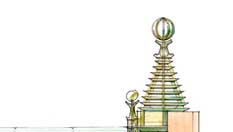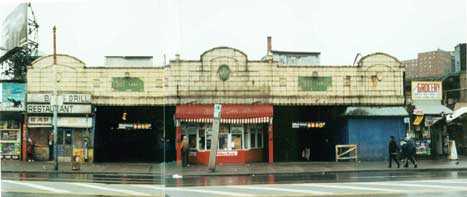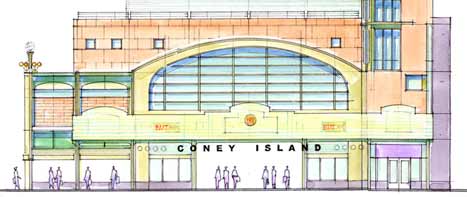
Page 5
On that same date, as the new President
Warren G. Harding presided over the beginning of the
“Roaring ’20s,” the double-fare for Coney
Island-bound travelers was dropped. The new 5-cent fare ushered
in Coney’s busiest era.
The new terminal featured unprecedented
flexibility with its eight tracks able to receive trains from
the West End and Sea Beach Lines from the north, with the
Brighton Beach and Culver Lines entering from the south.
Provision was even made in this grand structure to continue the
Culver service to Norton's Point on an elevated structure west
over Stillwell Avenue, but by the time the terminal opened, the
elevated service to Norton's Point was discontinued and
trolleys were substituted, terminating at their own platform
opposite the main terminal.
Letter Confusion
The tracks at the station were lettered A
to H, which led to a curious problem. In 1954, the City of New
York, having taken over the BMT (reorganized from the original
BRT) in 1940, brought its own IND subway into Stillwell Avenue
Terminal by taking over the Culver Line. The problem was that
the IND identified its trains by letter codes, as in the
"A train" made memorable by Duke Ellington. The new
entry at Coney Island was known as the D train. Well, this D
train, having taken over the Culver Line's tracks also took
over the Culver Line's platform, which included Tracks E and F.
As you may guess, despite the fact that
there were many signs pointing riders to Tracks E and F to get
the D train, large numbers


New and old. The restored facade will bind the new station to
its historic roots. The old facade, pictured below and now
removed from the now-demolished entrance, shows the wear and
neglect of years. When IND trains joined BMT trains in the
station in 1954 the BMT LINES tiles were drilled into for
wooden signs, since removed. Both
illustrations courtesy di Domenico + Partners, LLP.

Authority gave in, and rather than oust the D Train or try to further educate the riders, they simply changed the station signs for Tracks A to H to read Tracks 1 to 8.
New West End Grows Old
Having served the millions, decades of salt spray and salt air, not to mention the neglect
of D train riders applied an early version of user-friendly interface logic to the situation and showed up on Track D to get the D Train. They sat down, took a load off their feet, and ended up on a Brighton Beach or Brighton-Franklin train to a completely unexpected destination. After a few years of this, the Transit
©2003 The Composing Stack Inc.
©2003 Paul Matus
Updated May 5, 2003
